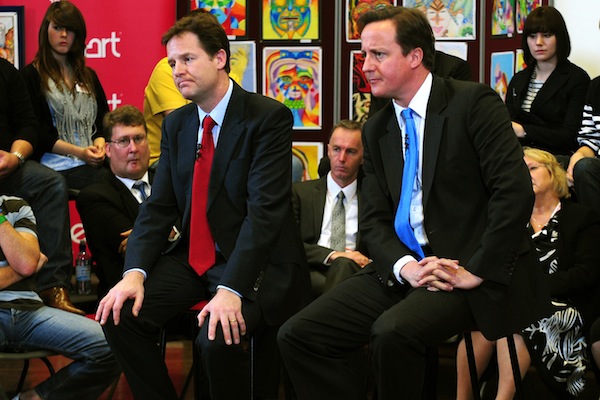David Cameron is making noises about further welfare cuts as he tours India, reports the FT’s Kiran Stacey. This isn’t surprising: the PM has got a gaggle of Cabinet ministers pecking at him and squawking about cutting DWP spending even more in order to protect policing and defence in the 2015/16 spending review, which will be settled in the next few months. But are we going to see the same pattern of decision-making and the same rhetoric on welfare spending as has emerged for previous budgets and autumn statements? This is how it has worked recently:
- Spending decisions approach.
- Nick Clegg (or an acolyte) says he’s blocked further cuts to the welfare budget. Iain Duncan Smith makes a similar noise.
- The Treasury (or sometimes even the PM) starts flying kites on welfare cuts.
- The Lib Dems say they won’t accept a deal without the rich taking another hit, namely through a mansion or wealth tax.
- A complex deal avoiding both of the above but involving welfare cuts is wrought.
- Ministers start talking about ‘strivers’ vs ‘scroungers’ to provoke Labour.
It was interesting to watch how the Liberal Democrats changed stance from their wealth-tax-or-no-cuts starting point in the summer to an Autumn Statement in December which included the decoupling of benefit rises from inflation, but no wealth tax, and no mansion tax. Danny Alexander was even less compromising when talking to the FT last week about the 2015/16 spending review, saying he believed welfare cuts had gone far enough. He didn’t even appear to be offering a deal. Nick Clegg has his party’s spring conference in a few weeks’ time, where he will doubtless be asked similar questions.
We could well see a similar journey to that outlined above, with the eventual spending review settlement containing further welfare cuts. In that case, George Osborne, ever the political strategist, will use this as an opportunity to flush out Labour on where it stands on welfare policy. That’s fair enough, as Tim Montgomerie observed in yesterday’s Times, it would be nice to know how the party would cope with the current economic climate, or indeed the post-2015 climate which will hardly be a sunlit upland either. But perhaps the debate could be a little less crude than it was at the time of the autumn statement.
The Tories made this about hard-working households vs sofa loafers with drawn curtains. An easy image to sell, sure, but the public didn’t really seem to buy it. YouGov polling after the Autumn Statement found 33 per cent of voters said it was right that benefits should only increase by 1 per cent each year, and 35 per cent saying benefits should have been increased in line with inflation or more. The gap widened a little when MPs came to vote on the measure in January, with 45 per cent backing the limit and 35 per cent rejecting it. But at that point Labour also managed to creep ahead of the Tories when it came to who voters trusted more on welfare, with 30 per cent saying they’d trust Labour and 22 per cent saying Conservative. There was also a fascinating backlash from across the commentariat and then from Tory MPs themselves against the rhetoric and images employed. So much for flushing out the opposition.
The problem was that the distinction wasn’t so much about workers vs shirkers or whatever stereotypes spinners preferred, but public sector vs the rest as the benefits uprating bill applied to working households. The awkward point for Labour (apart from the fact that Liam Byrne had used that same workers/shirkers dichotomy) was actually that it supported the government’s limit on public sector pay, but not a similar policy for benefits. Jonathan outlined this here.
So when the next round of cuts is agreed, and the Tories want to really fight Labour on welfare, they’ll need to work out a more nuanced attack line. In the meantime, we can watch the two Coalition parties travelling a familiar road as they negotiate the next round of cuts.







Comments